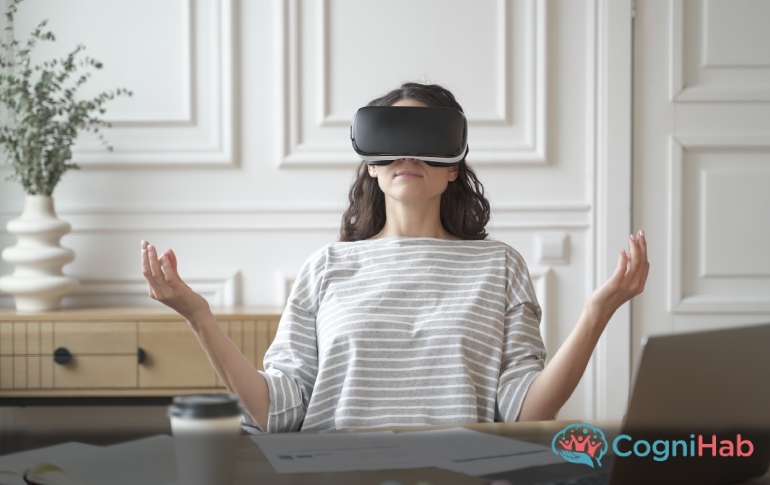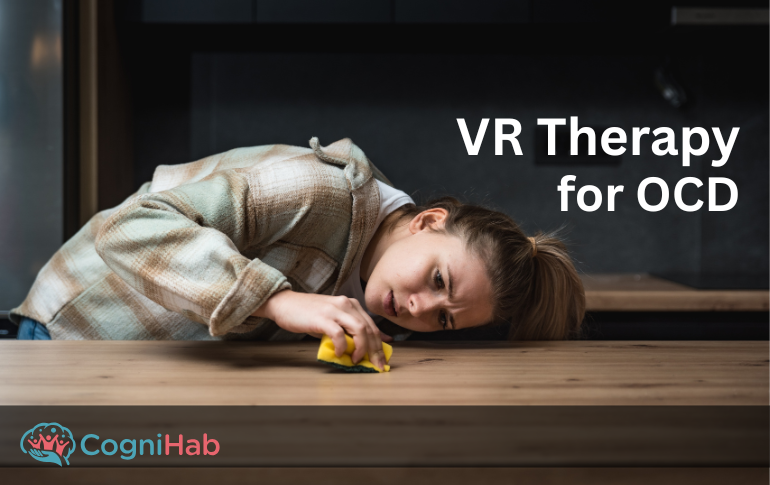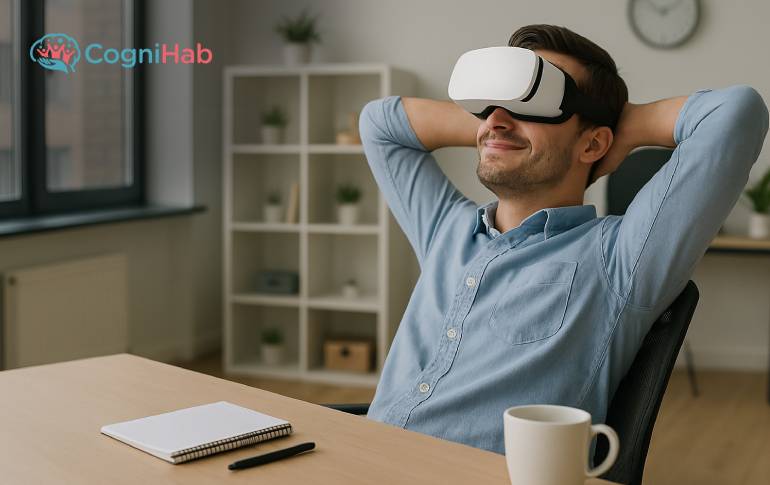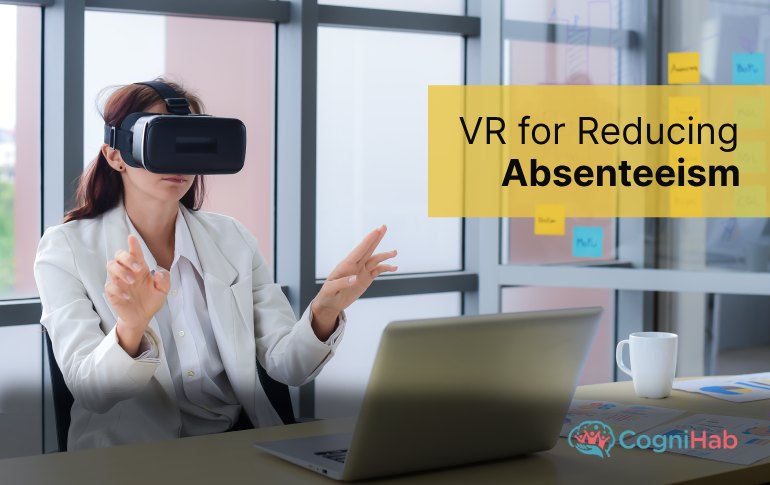How VR Journeys Transform Work Quality in Modern Workplaces?
VR has evolved far beyond gaming and entertainment, it is now another choice for enhancing workplace productivity, mental wellness, and overall work quality. In today’s fast-paced, high-stress work environments, companies are increasingly turning to VR Journeys to help employees manage stress, build resilience, and perform at their best.
The impact is measurable:
- Employees using VR mindfulness programs report 23% lower anxiety levels (PwC).
- VR-trained workers complete learning programs 4x faster with 75% better retention than traditional methods.
- Companies investing in VR wellness initiatives see 28% lower burnout rates and stronger team cohesion.
This article explores how VR Journeys are reshaping modern workplaces, the science behind its effectiveness, practical implementation strategies, and the future of AI-powered VR in employee well-being.
What are Virtual Reality Journeys?
VR Journeys are immersive, guided virtual experiences designed to support mental wellness, focus, and emotional balance. Unlike generic simulations, these journeys are personalized—transporting users to calming environments like forests, beaches, or cosmic spaces.
They help reduce stress, enhance clarity, and promote relaxation in just a few minutes. Whether used in workplaces for employee wellness or in healthcare for therapy, VR journeys provide a powerful, science-backed way to improve well-being and performance through deeply engaging and realistic virtual settings.
Forest Walk Virtual Reality Journey
How Virtual Journeys Transform Work Quality?
Work quality isn’t just about skills—it’s about state of mind. Virtual journeys offer employees a powerful way to mentally reset, reduce stress, and restore focus in the middle of demanding workdays. These immersive experiences simulate calming environments that activate the brain’s relaxation and attention centers, leading to improved cognitive function and emotional balance.
The result? Sharper decision-making, fewer mistakes, and more thoughtful work.
Also read, Innovative Wellness Ideas for Workplaces
Why Work Quality Matters More Than Ever
In today’s fast and tech-driven world, work quality stands out as the true differentiator. It builds trust, strengthens reputations, and ensures long-term impact. While speed matters, it’s the precision, thought, and care behind the work that drives real value.
The High Cost of Poor Work Quality
Work quality isn’t just about efficiency—it’s about employee well-being, engagement, and long-term business success. Consider these critical findings:
- Poor work quality costs U.S. businesses $3.1 trillion annually.
- Companies with strong wellness cultures experience 50% higher employee retention.
- 83% of employees say mental health support directly improves their productivity
The Link Between Mental Health and Performance
Strong mental health fuels focus, resilience, and clarity—directly impacting performance, decision-making, and overall workplace productivity.
Chronic stress and burnout lead to:
- Decreased cognitive function
- Higher absenteeism and turnover.
- Lower team morale and collaboration.
The Science Behind VR Journey's Effectiveness
Virtual Reality is more than visual immersion, it’s grounded in neuroscience and behavioral psychology. By engaging multiple senses simultaneously, VR Journeys stimulates the brain in ways traditional methods cannot. It activates the motor, cognitive, and emotional centers, making experiences feel real, memorable, and transformative.
Why VR Trip Feels Real (And Why That Matters)
Studies in neuroscience confirm that the brain processes VR experiences similarly to real-life events. This phenomenon, known as "presence," makes VR uniquely effective for:
- Stress reduction (immersive nature environments lower cortisol levels).
- Emotional recovery (guided VR therapy helps process trauma).
- Skill-building (practicing high-pressure scenarios in a safe space).
Unique Ways VR Journeys Enhances Work Quality
Many jobs (healthcare, emergency response, finance) involve trauma, high-pressure decisions, and emotional fatigue. VR provides a controlled environment to:
- Decompress after critical incidents (e.g., hospital staff using VR to process traumatic events).
- Simulate stressful scenarios (e.g., executives practicing crisis management).
- Build emotional resilience without real-world consequences.
Team-Based Mental Wellness
Unlike traditional meditation apps, VR enables shared relaxation experiences, fostering team connection. Examples include:
- Guided group meditations in serene virtual spaces.
- Virtual team retreats (e.g., a forest walk or beachside mindfulness session).
- Collaborative stress-relief games that promote bonding.
Why It Works:
- Synchronized relaxation improves team cohesion.
- Remote teams feel more connected despite physical distance.
Data-Driven Mental Health Support
VR doesn’t just help employees relax—it tracks progress and personalized interventions. Key features:
- Real-time biofeedback adjusts sessions based on stress responses.
- AI-powered analytics identify patterns in employee well-being.
- Personalized recommendations (e.g., suggesting a meditation when stress levels spike).
Practical VR Journeys Solution for Businesses (With ROI Breakdown)
| Solution | Best For | Key Benefit | ROI Data |
| VR Mindfulness Breaks | All employees | Reduces stress by 23% in 10-minute sessions | 27% productivity boost (Stanford) |
| Virtual Therapy Rooms | Remote/hybrid teams | Confidential support without office stigma | 40% higher engagement (Forrester) |
| Resilience Training | High-stress roles | Improves coping skills via immersive scenarios | 41% better stress management (Deloitte) |
| Burnout Prevention | Leadership & overworked staff | Cuts burnout risk by 28% with daily VR use | $15K saved per employee (Harvard Business Review) |
| Emotional First Aid | Crisis response teams | Helps process trauma through guided VR | 32% faster recovery (Journal of Occupational Health) |
Also read, VR for Reducing Absenteeism
Step-by-Step VR Implementation Guide
Phase 1: Pilot Program
- Select a test group (e.g., customer support, nurses, sales teams).
- Set measurable goals (stress reduction, absenteeism rates).
- Choose 4-5 VR headsets (Meta Quest 3, PICO 4).
- Get the Cognihab Vr mindfulness Suit and train you employee
A Fortune 500 company piloted VR with IT staff and saw 27% lower stress levels in 8 weeks.
Phase 2: Measure & Optimize
- Analyse Cognihab Analytics.
- Compare pre- and post-VR stress metrics.
- Refine the program based on results.
Phase 3: Company-Wide Rollout
- Expand to other departments.
- Integrate with existing wellness programs.
- Use AI analytics to predict burnout risks.
The Future: AI + VR for Smarter Workplaces
The next frontier combines AI personalization with VR immersion:
1. Adaptive Mental Wellness
AI tailors VR sessions in real-time based on mood, stress levels, and preferences.
2. Virtual Wellness Coaches
AI-powered avatars guide employees through therapy, meditation, and resilience training—24/7.
3. Predictive Mental Health Analytics
AI detects early signs of burnout and suggests interventions before productivity drops.
4. Inclusive Support Systems
Employees uncomfortable with traditional therapy access judgment-free, private VR tools.
5. Enhanced Remote Collaboration
VR meeting spaces with AI-driven mood optimization (e.g., calming virtual environments for tense discussions).
Conclusion
Virtual Reality Journey is no longer a futuristic concept—it’s a proven, scalable solution for enhancing work quality through:
- Reduced burnout and stress.
- Stronger team collaboration.
- Data-driven mental health support.
The workplaces of tomorrow won’t just be hybrid or remote—they’ll be immersive, adaptive, and human-cantered.






